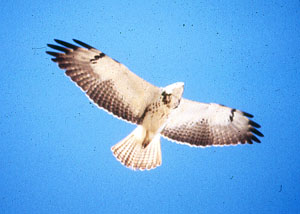

I have little to add to Matt Heindel's excellent commentary on the hawk except that Swainson's Hawks take two years before reaching adult plumage unlike most other Buteos which take only one year. I agree that this bird looks more like juvenile than Basic I which has broader dark subterminal bars on the wing and tail.. Another feature eliminating Ferruginous Hawk is the number of emarginate (slotted) primaries. Only three on Swainson's, four or more on Ferruginous.
I am as confused by the duck as anybody. Don DesJardin wrote: "Here is a photo of a Ruddy Duck I took several years ago at the Ventura Waste Water Treatment Plant. You wouldn't believe how many people were calling this in as a Masked Duck...."
The bird is clearly in the genus Oxyura but it does not look like any Ruddy Duck I have ever seen. Looking in Waterfowl: An Identification Guide to Ducks, Geese, and Swans of the World By Steve Madge and Hilary Burn, I found several possibilities. Immature male White-headed Duck has a dark head, but a different bill shape. Maccoa Duck from Africa and the dark headed race of Ruddy Duck from Peru (Oxyura jamaicensis ferruginea) have a chestnut, not black foreneck. This leaves the Argentine Blue-bill (Oxyura vittata) and the Blue-billed Duck (Oxyura australis) from Australia in which the male has an all dark head and foreneck. The latter seems to be a better fit because of its duller brown coloration, mottled breast, and dull-white undertail coverts. I suspect that the bill color varies seasonally as it does with the Ruddy Duck, so I'm not terribly concerned about that.
I have no experience with Blue-billed Duck, and without experience it's dangerous to identify an unknown from a book. I suspect it might be an escapee from a zoo or avicultural collection but Todd Waterfowl - Ducks, Geese and Swans of the World (1979) lists Austrailian Blue-billed Duck's status in captivity as follows: "Have never been maintained outside of Australia, but has been bred there. Rare, even in Australian collections." Of course, it's possible the situation may have changed in recent years.
Another possibility is that it may have been a melanistic Ruddy Duck, a genetic mutation or a "throw-back." Dark heads appear on several species of Oxyura and it is possible that the gene for this trait may appear sporadically in the Ruddy Duck population. Steven Mlodinow's comments suggest that this trait may appear occasionally within the Ruddy Duck population. Another possibility is that the bird has been oiled. In any event, it certainly is not a Masked Duck.
Original photos are below.
 |
|
| This mystery hawk was photographed in spring 1989 in California City and is contributed by Matt Heindel. Click on image to view full size. | Here is a puzzler contributed by Don DesJardin. Image is already full size. For more of Don's work, visit his new photo gallery here. |
What do you think these birds are? Please click here to view comments or add your own. Thank you very much for contributing your thoughts.